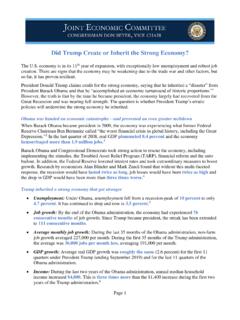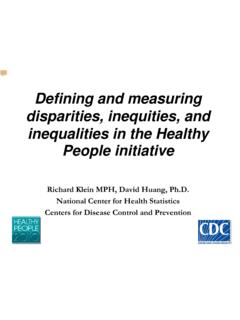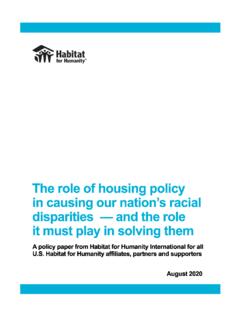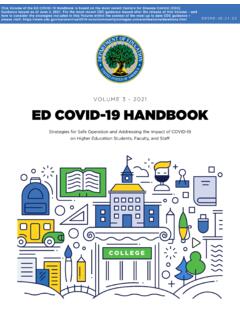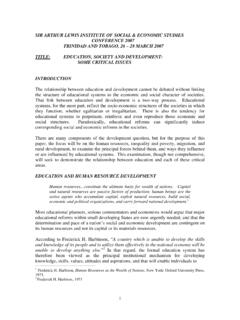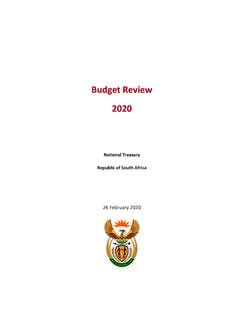Transcription of The Impact of Coronavirus on the Working Poor and People ...
1 The Impact of Coronavirus on the Working Poor and People of Color The Coronavirus pandemic has caused the deaths of over 50,000 Americans, including those from every region, race and socioeconomic background. However, the virus has hit hardest those of modest means, particularly Black Americans, far out of proportion to their numbers. While it has long been understood that wealth, race and health are closely tied, COVID-19 has focused attention on the high human cost of structural inequalities in American society. Research shows that poor and Working poor Americans are most vulnerable to COVID-19. They are much more likely to have underlying health conditions like hypertension, chronic lung disease, diabetes and heart disease.
2 A preliminary study by the Centers for Disease Control (CDC) finds that nearly nine of 10 individuals hospitalized with COVID-19 suffer from such Black Americans are twice as likely as White Americans to live in poverty. Partly as a result, they are more likely to contract the virus, be hospitalized for it and die from it. While no comprehensive national data are yet available, a preliminary CDC report found that one-third of those hospitalized were Black, while they made up only 18% of those in the In New York City, which has suffered the largest outbreak of COVID-19, Blacks are twice as likely as Whites to die from the Nevertheless, there have been reports that Blacks showing symptoms of the Coronavirus may be less likely to be tested for The Working poor are more likely to be exposed to the contagious illness because they are more likely to have jobs in parts of the service sector that put them in close contact with the public for example, as home health aides, grocery clerks.
3 Restaurant workers and housekeepers. These occupations are disproportionally held by Black Americans and Latinos. They also are far less likely than better-paying jobs to offer paid sick leave or health insurance. Almost none of them offer the opportunity to work from The poor, Working poor and People of color will disproportionally suffer from the massive recession caused by the pandemic. Working -poor service sector workers have been hit particularly hard by massive layoffs caused by stay-at-home orders. Historically, the unemployment rate for Blacks is roughly twice that for Black Americans also have far less wealth to help them survive an economic crisis, with the median Black household holding only about $17,000 in total assets approximately one-tenth of White These massive disparities are partly the result of persistent discrimination.
4 Economic inequality in the United States strongly determines who will be most likely to be hospitalized or die from COVID-19 and who will be most harmed by its economic Impact . As a result, the virus likely will increase inequality, disproportionately hurting the poor, Working poor and communities of color. If these underlying conditions are not addressed, the next pandemic could have even more painful results. The Impact of Coronavirus on the Working Poor and People of Color Page 2 THE RISK OF CONTRACTING THE Coronavirus The poor and Working poor are most likely to have medical conditions that are risk factors The relationship between health and socioeconomic status flows in both directions: the wealthy effectively can buy better health, and the healthy are better able to become wealthy.
5 The poor can t afford the health insurance and medical services necessary to stay healthy, making them less able to escape from being poor. Research has found that Americans living below the poverty line and with lower household incomes are 50% more likely to see their treatment for asthma Another study found that of individuals living at or below the poverty level were at high risk of developing heart disease, compared to of high-income Low-income individuals are twice as likely to have diabetes and four times more likely to smoke (36% vs ).10 COVID-19 has a particularly devastating effect on those with health conditions associated with poverty. The Centers for Disease Control (CDC) reports that nearly 90% of those hospitalized with COVID-19 in their study had one or more underlying health condition, including hypertension ( ), chronic lung disease (primarily asthma, ), diabetes ( ) and heart disease ( ).
6 11 There are strong relationships between socioeconomic status (SES; a measure of social and economic well-being that often includes income, wealth and education ) and these chronic health conditions. Black Americans are more likely to live in poverty and suffer the chronic health conditions associated with it Black Americans are over twice as likely to live in poverty as White Americans, with just 8% of non-Hispanic White Americans living under the poverty line compared to 21% of Black Americans. Black Americans also face much higher rates of child poverty in America, with under-18 poverty rates close to or exceeding 30% and regularly tripling the rates for White In part because of this greater exposure to poverty, Black Americans are also more likely to suffer from the medical conditions that are high-risk factors for serious complications or death from Coronavirus .
7 Forty-two percent of Black Americans had hypertension between 2015 and 2016, compared to just of White Black Americans had a much higher death rate from heart disease than White Americans (208 per 100,000 vs 169 per 100,000).14 And Black children were nearly twice as likely to report having asthma as White children ( vs ).15 Those living in poorer neighborhoods are at elevated risk Research has shown that living in poor, cramped housing conditions and crowded neighborhoods increases the risk of viral infection. Early studies of the R naught of COVID-19 a measure of how many People will get sick for each infected person suggest that it could be more contagious than either H1N1 or the 1918 influenza pandemic The Impact of Coronavirus on the Working Poor and People of Color Page 3 In the Coronavirus outbreak, early reports from New York City have shown that low-income, crowded neighborhoods have indeed been the hardest hit.
8 For example, Borough Park in Brooklyn, which has a poverty rate of more than 30%, has one of the highest rates of confirmed COVID-19 Neighborhoods in the bottom quartile (25%) of incomes represent more than one-third of COVID-19 cases (36%) in the city, while the wealthiest quartile accounts for less than one in The concentration of confirmed COVID-19 in New York City cases also correlates with race. Six out of the 10 ZIP codes with the highest number of confirmed COVID-19 cases are majority Black or The clustering of Black families in certain neighborhoods is in part a result of decades of segregation, which have not been fully overcome by the Civil Rights Act and other legislative remedies.
9 Black families are more likely to live in neighborhoods with fewer public resources, that are exposed to pollutants and that have a lack of healthy food options, even when they are not poor, in large part due to racial residential Racial segregation has similar negative effects on health outcomes for Black Americans. Black and Latino families are also more likely to live in multigenerational housing than White families, increasing the odds of living in close proximity with others and with at-risk older adults. Twenty-seven percent of Latinos and 26% of Blacks lived in multigenerational homes in 2016 compared to just 16% of Service occupation workers are most vulnerable to contracting the virus Following the Bureau of Labor Statistics National Compensation Survey, service occupations include health care support, protective service, food preparation, building and grounds cleaning and maintenance and personal care, and are distinct from management, business and financial occupations (though these provide services as well).
10 These workers are at risk of exposure to Coronavirus due to the inherent person-to-person nature of the work, which also makes it near impossible for many service occupation employees to work from home. Employers in service occupations are also less likely to provide their workers with access to paid sick leave as compared to management occupations. Sixty-one percent of workers in service occupations had access to paid leave in 2019, compared to 94% of workers in management occupations. The Impact of Coronavirus on the Working Poor and People of Color Page 4 In 2019, just 1% of all workers in service occupations had access to a flexible workplace, which would allow them to complete their work at home or an approved alternate location.









